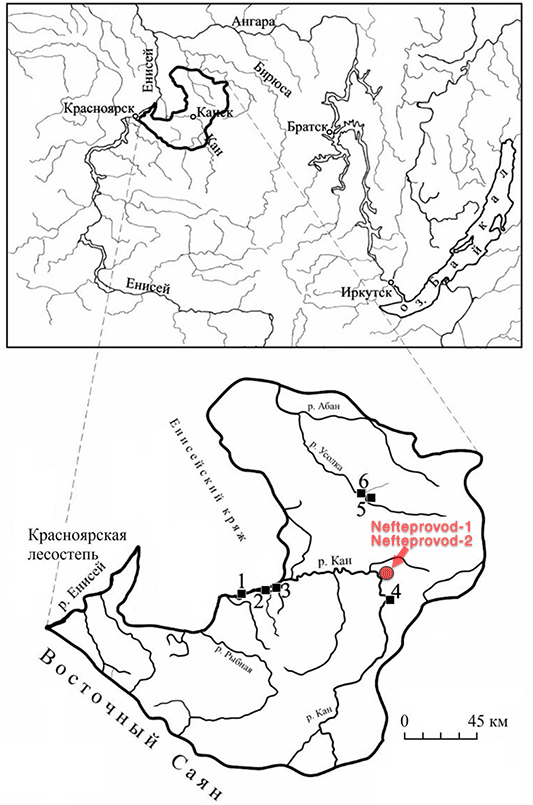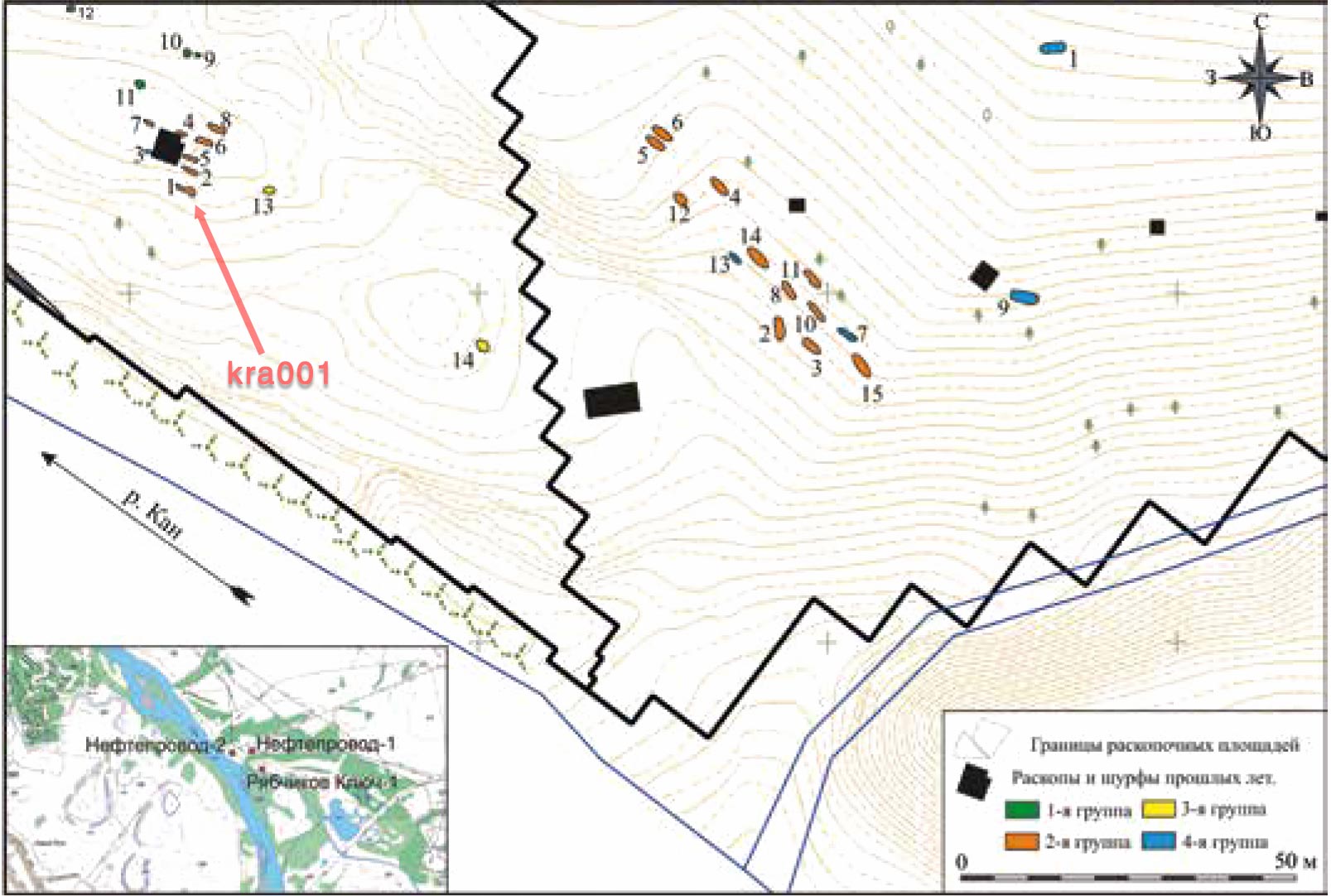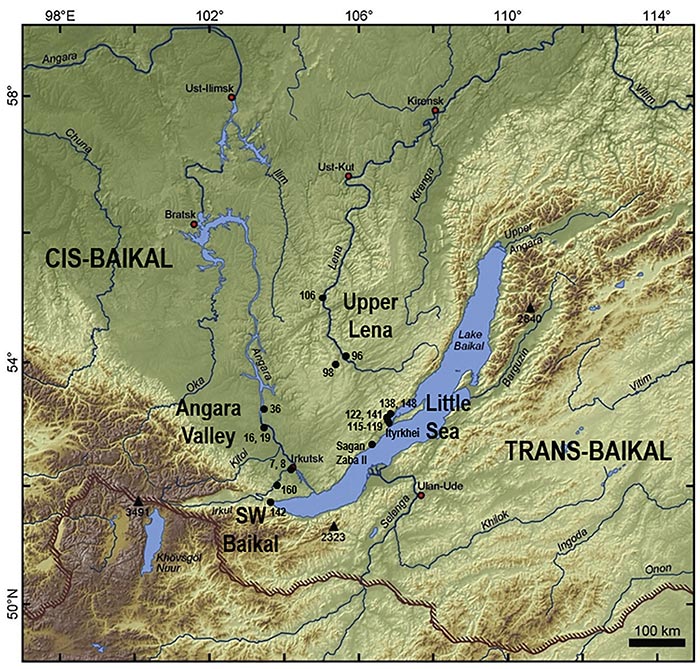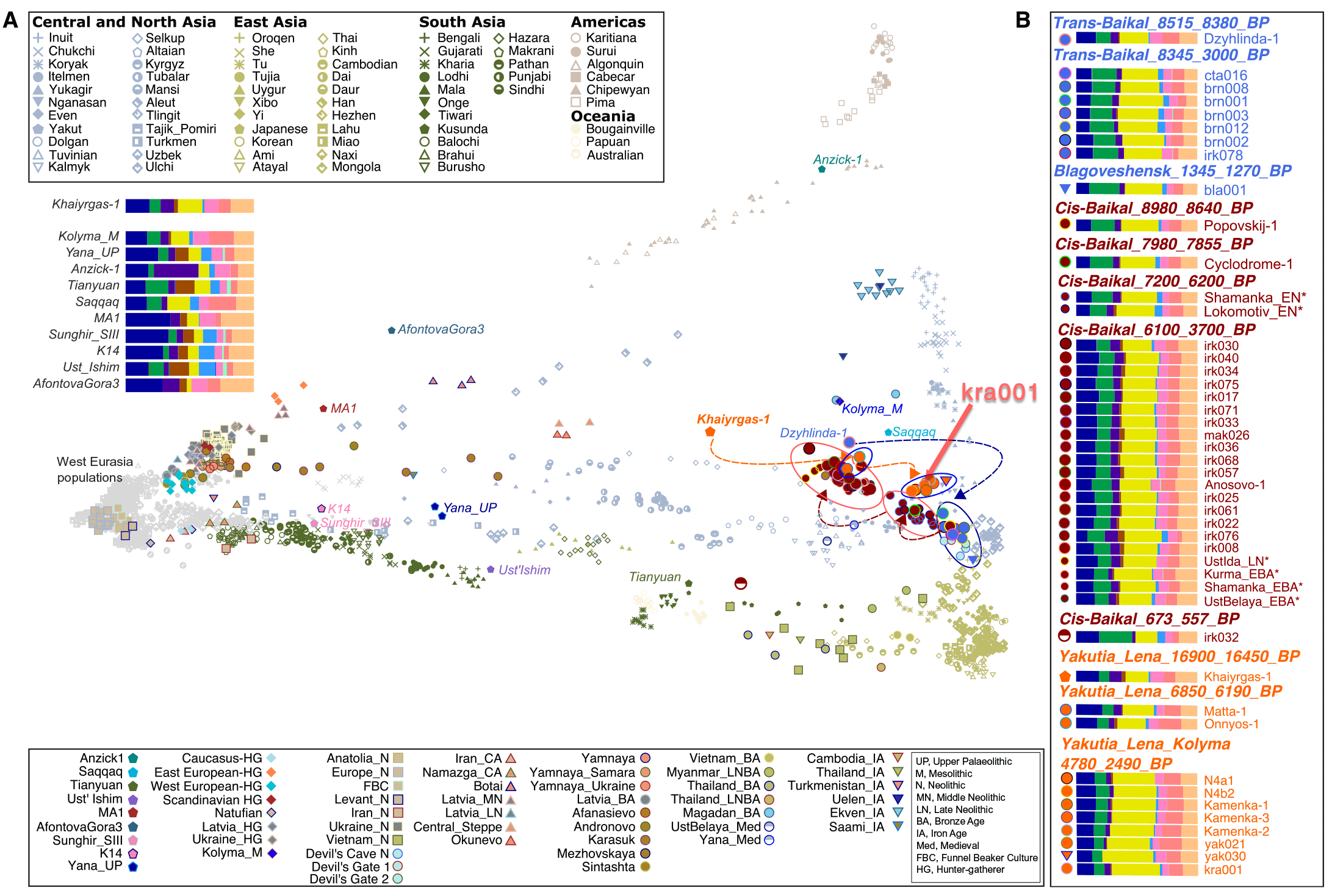This is an update to the data from Human population dynamics and Yersinia pestis in ancient northeast Asia, by Kılınç et al. Science Advances (2021).
Files have been released, and some of them are huge, so it might take me some time to analyze them all and include specific subclades in the Ancient DNA Dataset.
For the moment, the sample I highlighted in the previous post, kra001 (2336-2135 calBCE), mtDNA C4b1, from burial Nº1 of Nefteprovod-2, is of very good quality, and it would not be surprising if it made its way to YFull’s tree. It can be best described as N1a-L1026*:
- N>L735>F1206>L729>Tat>F1419>L708
- N>L735>F1206>L729>Tat>F1419>L708>M2005
- N>L735>F1206>L729>Tat>F1419>L708>M2005>L1026
- N>L735>F1206>L729>Tat>F1419>L708>M2005>L1026>B479>B511
- N>L735>F1206>L729>Tat>F1419>L708>M2005>L1026>B479>B516
- N>L735>F1206>L729>Tat>F1419>L708>M2005>L1026>Y6058, including
- N>…>L1026>Y6058>B197
- N>…>L1026>Y6058>CTS10760, which includes
- N>…>L1026>Y6058>CTS10760>CTS2929/VL29
- N>…>L1026>Y6058>CTS10760>PH1266
- N>L735>F1206>L729>Tat>F1419>L708>M2005>L1026>Z1936, and derived SNPs
The only SNP not available to call this haplogroup basal, as far as I can tell, is B479; that is, unless FTDNA finds a modern relative to split the L1026 branch. These Y-SNP calls make it the ‘most archaic’ hg. N-L1026 found to date, predating those two (probably also basal) N-L1026* from the MBA Lovozero culture of Bolshoy Oleny Ostrov (ca. 1610-1436 calBCE).
*BOO002 is N1a-L1026 (xB511, xB516, xB203, xP89, xCTS2929/VL29, xPH1266, xZ1936)
*BOO004 is N1a-L1026 (xB511, xB516, xB202, xP89, xCTS2929/VL29, xPH1266, xZ1936)
In fact, the closest connection with the asbestos-mixed Lovozero ceramics is found in the Vardøy ceramics from the Taymyr peninsula, much further to the east, at the mouth of the Yenisei River – i.e. downstream from the Kansk forest-steppes where Nefteprovod-2 is located.
#EDIT-1: From the same cluster of the Yenisei – Lena river basins, Yakutia_Lena_Kolyma_4780_2490_BP:
- Central Yakutia LN N4a1 (2832-2474 calBCE), mtDNA A12a, from Kyordyughen 2, of lesser quality, shows Y-SNP calls compatible with hg. N>L735>F1206>L729>Tat>F1419>L708>M2005>pre-M2019 with 2 derived SNPs and 4 ancestral at the M2019 level.
- Central Yakutia LN N4b2 (2398-2141 calBCE), mtDNA A12a, from Kyordyughen 1, burial 1, shows Y-SNP calls clearly compatible with N>L735>F1206>L729>Tat>F1419>L708>M2005>pre-L1026, with 9 positive SNPs and 22 negative SNPs at the L1026 level.
- Central Yakutia IA Yak030 (795-542 calBCE), mtDNA C4b3, from the Dyupsya burial, of lesser quality, likely of hg. N>L735>F1206>L729>F1360>F4309>CTS6380>Y3192, although no SNPs are found at the N-CTS6380 level, and two derived, one ancestral (P43, 1x G->A) at the N-Y3192 level.
From the Yakutia_Lena_6850_6190_BP group:
- Central Yakutia MN N5a (4340-4236 calBCE), mtDNA D3, from the Onnyos burial (Amga river), is probably of hg. Q>MEH2>M346>L53>pre-YP3961 with 3 derived SNPs and 3 ancestral at the YP3961 level.
So, it turns out that the “most archaic” haplogroup (that will probably split the L1026 branch) comes from farther east, from Central Yakutia, which makes the Cis-Baikal area the likely origin of N-M2005 expansions during the transition of the Middle to Late Neolithic.
#EDIT-2: From the Trans-Baikal_8345_3000_BP cluster:
- Trans-Baikal Mesolithic irk00x (6564-6429 calBCE), mtDNA C*, from Dzhylinda-1 (Buryatia), is possibly of hg. C>M217>F1906>F3447>F6301? There are ancestral calls at the F1906, F3447, and F6301 levels, so difficult to say if it is actually pre-F6301 or even upstream.
- Trans-Baikal Neolithic brn008 (5511-5374 calBCE), mtDNA D4, from Izvestkovaja-1, burial 1 (Kuenga river, Sretensky District), shows Y-SNP calls compatible with hg. N>L735>F1206>L729>Tat>F1419>pre-L708 with 19 derived SNPs and 8 ancestral at the L708 level.
- Trans-Baikal Neolithic brn003 (4690-4519 calBCE), mtDNA D4, from the Dvorcy-Dacha burial (Kadalinka river), shows Y-SNP calls compatible with hg. N>L735>F1206>L729>Tat>F1419>L708>pre-M2005 with 8 derived SNPs and 6 ancestral at the M2005 level.
- Trans-Baikal Neolithic brn002 (4231-3990 calBCE), mtDNA D2a’b, from Nozhyj Lake burial site-2, burial 6, individual 3 (Agin-Buryat Autonomous Okrug), appears to be of hg. N>L735>F1206>L729>F1360>F4309>pre-CTS6380, although there are some ancestral calls at the F4309 level, too. The lack of a common pattern of those ancestral calls with irk007 below suggests that either both are pre-CTS6380, or at least this sample is.
From the Cis-Baikal_8980_8640_BP cluster:
- Cis-Baikal Early Neolithic irk007 (7030-6693 calBCE), from Popovskij Lug, is possibly of hg. N>L735>F1206>L729>F1360>F4309>pre-CTS6380, although there are some ancestral calls at the F4309 level, too.
All data taken together suggest that, more or less as expected, the highest diversity of (and ‘most archaic’) N1a subclades come indeed from the Circum-Baikal Early Neolithic, in line with the recently reported Neolithic N1a-Tat sample M54A (ca. 5480-5370 calBCE) from the Houtaomunga site, Jilin, in the Amur River basin.
#EDIT-3 (1/12/2021): from the Cis-Baikal_673_557_BP cluster:
- Cis-Baikal Medieval irk032 (1277-1393 calCE), mtDNA D6c, from Zarubino site, burial 3 (Angara river, Irkutsk Oblast), is most likely of hg. I2>CTS2257>L460>P37>M423>S2770>CTS5375>CTS7213>L621>CTS10936>S19848>CTS4002>CTS10228>S20602>Y4460>Y3106>A6106, without controversial calls as far as I can see.
The Anzhevsky Complex of archaeological sites
Recent open access paper (in Russian) Anzhevsky Complex of archaeological site – new Asynchronous burial in the territory of the Kansk-Rybinsk Basin. Preliminary data, by Timoshchenko, Vybornov, & Rybin (2018).
Interesting excerpts (emphasis mine, stylistic changes to the abstract for clarity):
The sites of the Anzhevsky complex were discovered in 1972 by N.A. Saveliev. They are located in the Kansk forest-steppe, territorially positioned in the Kansk-Rybinsk basin, on the right bank of the Kan River in the administrative boundaries of the Ilan municipal District of the Krasnoyarsk Krai. In the course of the archaeological excavations of 2015–2016 a multilayered burial ground was discovered, containing 29 graves, that was functioning throughout the Neolithic – Middle Ages.

The Anzhevka complex of monuments currently includes archaeological objects designated in the documentation as “Anzhevka. Nefteprovod-2 site (Novosmolenka-2)”, “Anzhevka. Nefteprovod-1 site (Smolenka)”, “Karapsel. Location of Ryabchikov Klyuch-1”, “Karapsel. Ryabchikov Klyuch-2 site”. Archaeological sites are located in the Kansk forest-steppe, geographically located in the Kansk-Rybinsk depression, on the right bank of the river Kan within the administrative boundaries of the Ilanskiy municipal district of the Krasnoyarsk Territory. The sites Nefteprovod-1 and Nefteprovod-2 have a common border, independent of the landscape and the nature of cultural deposits.
The burial ground is located on the surface of a series of complex landslide bodies that stand out above the floodplain of the river Kan by two terraced ledges connected with a shallow graded valley of the watershed. The stratigraphic position of culture-bearing sediments in the excavation at the site is associated with subaerial deposits of the Holocene age. Archaeological material is mainly recorded in the first layer – dark gray humus sandy loam (early Iron Age – Middle Ages) and the second layer – brown grayish sandy loam (Neolithic – Bronze Age).
Preliminary analysis of the obtained materials can identify 4 groups of burials.
- Burials of the Neolithic time constitute the first group (3 burials). Partial analogies in the funeral rite can be found in the burials of the Zelenogorsk burial ground and burial site of Popikha, located on the middle stream of the Kan River, as well as in the Serovsk burial tradition of the Baikal region.
- The second group (16 burials) dates from the Late Bronze Age and is preassigned to the Krasnoyarskaya Culture.
- The third group (2 burials) also dates from the Bronze Age, but it is connected with the taiga area of the Bronze Age cultures of the Baikal region and the Northern Angara River.
- The fourth group (5 burials) dates from the Early Iron Age – the Middle Ages.
At the moment, this chronological segment in the archaeology of the Kansk forest-steppe has hardly been studied. The emphasis is made on the burial with the bronze celt of the Tagar period and burial containing protective equipment in the form of bone armor.

At the Nefteprovod-2 site, 14 burials were recorded.
Burial No. 1. The structure over the grave is a scattered accumulation of stones. An incomplete human skeleton was recorded. Some preservation of anatomical order was observed, which helped determine that the deceased was laid in the east-west direction, with his head to the east. The skull itself, as well as its remains, were not found. No accompanying material was found.
Kansk-Rybinsk LN/EBA vs. Krasnoyarsk-Kansk LBA
The radiocarbon date of sample kra001 suggests that burial Nº1 belongs to the earlier layer of materials, corresponding to the Bronze Age in the Kansk-Rybinsk depression, rather than – as initially inferred by archaeologists – to the later, LBA Karasuk-related Krasnoyarsk-Kansk forest-steppe group (see e.g. Mandryka & Snotrysova 2018).
This date would connect this individual thus to neighbouring materials from Zelenogorsk (see e.g. Abdulov et al. 2015) and Popikha (see e.g. Timoshchenko & Savelyev 2011), and all of them to the Cis-Baikal Serovo burial complex (see e.g. Basalyiskiy 2012, Goriunova et al. 2018).
NOTE. For chronological maps of archaeological sites of the Krasnoyarsk Krai in general and the Kansk forest-steppe in particular, see Tolkatskiy (2011).
Serovo cultural complex vs. Glazkovo culture
The Late Neolithic Serovo cultural complex predated thus the Glazkovo tradition (which marked the transition to the EBA in the Cis-Baikal area), which seems to continue a great part of its material culture. However, the following data support that Glazkovo represents a different population which replaced N-rich Cis-Baikal groups:
- (1) population size estimates for kra001 suggesting a bottlenecked population;
- (2) the tight cluster formed by the Yakutia_Lena_Kolyma_4780_2490_BP group (to which kra001 belongs) relative to neighbouring roughly coeval groups; and
- (3) Y-DNA hg. N-Tat from the samples of the cluster in the Late Neolithic (ranging from the Angara Valley to the Lena River Basin), compared to the predominant hg. Q1(b) among the available Glazkovo (or related) samples reported in Damgaard et al. (Science 2018) and Yu et al. (2020).
From Waters Rist et al. J. Archaeol. Res. Asia (2021), emphasis mine:
In this research, we focus on the Little Sea Microregion and the shift between the Serovo (ca. 5280–4586 calBP) and Glazkovo (ca. 4955–3565 calBP) mortuary traditions, which is typically used to mark the transition from the Late Neolithic (LN) to Early Bronze Age (EBA)1 (Weber et al., 2020). There is close cultural affiliation between these two mortuary traditions, as evidenced by continuity in carbon-14 dates as well as similarities in mortuary practices and material culture, including burial form, grave architecture, spatial organization of cemeteries, and the use of fire in grave pits (Weber and Bettinger, 2010).
Ancient DNA and dental nonmetric data suggest the Serovo and Glazkovo were genetically continuous populations (Mooder et al., 2010; Waters-Rist et al., 2015), although this continuity might be less pronounced than previously thought (Moussa et al., 2020). However, there are also changes between mortuary traditions, including the appearance of copper alloy and polished nephrite artifacts, larger Glazkovo cemeteries, new pottery styles, fewer graves with multiple burials, an increase in exotic and labour-intensive objects, different orientations of individuals in graves, and increased heterogeneity in grave good distribution between Glazkovo individuals (Weber, 1995; Weber et al., 2002; Weber and Bettinger, 2010).

Angara Valley: 8–Lokomotiv, 14–Kitoi, 19–Ust’-Belaia, 16–Galashikha, 60–Serovo, 36–Ust’-Ida I, 160–Moty-Novaia Shamanka
Southwest Baikal: 142–Shamanka II
Little Sea: Ityrkhei, 141–Khuzhir-Nuge XIV, 148–Khadarta IV, Sagan–Zaba II
Upper Lena: 96–Verkholensk, 98–Obkhoi
Research exploring the extent and nature of cultural continuity and change between the Serovo and Glazkovo has received less attention than the more dramatic changes seen between earlier cultural transitions (e.g., the Early Neolithic vs. Middle/Late Neolithic) (McKenzie, 2010; Shepard, 2012; Weber et al., 2002). Shepard (2012); Shepard et al. (2016) has proposed that the change from Serovo to Glazkovo mortuary protocols reflects a change in socio-political organization. Specifically, he suggests that the Serovo political economy emphasized corporate strategies involving local resources while the political economy of the Glazkovo shifted to include network-orientated exclusionary strategies that emphasized status distinctions between individuals. Weber, (2020) argues the change is due to the introduction of a new form of socioeconomic organization involving any of the following: new mechanisms of land tenure, new patterns of group formation, expanded exchange networks, and/or lower competition between gender and age groups. Whatever the case, there is clear evidence and agreement about the presence of non-local individuals in Little Sea EBA-Glazkovo cemeteries. Different scenarios to explain the influx of non-locals include a larger seasonal round, more long-distance ‘macro-regional’ interaction, and/or the prosperity of Little Sea Glazkovo society drawing in individuals from neighbouring groups (Haverkort et al., 2008; Shepard et al., 2016; Weber, 2020; Weber and Goriunova, 2013).
Of interest is also the referenced paper (submitted to the same journal) where these genetic differences will be reflected, which might include a shift from N to Q lineages, and hopefully also a correction of those early “R1a” reported by Moussa’s team for Baikalic cultures:
Moussa, N.M., McKenzie, H.G., Bazaliiskii, V.I., Goriunova, O.I., Bamforth, F., Weber, A. W., 2020. Insights into Lake Baikal’s ancient populations from genetic evidence at the Early Bronze age cemetery Kurma XI and the Early Neolithic Shamanka II. Archaeological Research in Asia (submitted).

An indirect way to reject that this burial actually belongs to the MLBA Krasnoyarskaya culture is thus to rely on its ancestry and Y-DNA, which shows a connection with other sampled earlier groups from Cis-Baikal and Yakutia, and not the ancestry and Y-DNA typical of Krasnoyarsk_MLBA samples published in Narasimhan et al. (2019).
Its early date and Cis-Baikal-related ancestry is perfectly compatible with the description of the burial, since no accompanying materials have been found. It would not be the first example of misclassified burials where archaeologists rely on surrounding burials or cemeteries (cases like the Althäuser family or Szólád’s burial 1 immediately come to mind).
On the other hand, outliers appear often at the (geographical or chronological) fringes of a culture’s territory, as in sampled late Corded Ware groups from Kuyavia, Switzerland, or Lesser Poland, so this could also be the first example of the infiltration of hg. N among LBA cultures derived from the Andronovo-like Horizon.
After all, multiple independent infiltration events and bottlenecks must have happened at different times in different regions before the spread of certain dialects, to get to the current varied Y-DNA and autosomal picture of some Uralic-speaking groups…
Featured image: Map of Siberia, from the Baikal Archaeology Project by Dr. Weber, at Wikipedia.
Related
- Haplogroup N-L708 & Q-L53 hotspot, around Lake Baikal
- Proto-Hungarian Homeland: East and West of the Urals?
- European hydrotoponymy (VIII): Meshchera, a Permian wedge between Volga Finns?
- Ancient phylogeography: spread of haplogroups R1b, R1a and N
- Afanasievo ancestry reached Lake Baikal; Nganasan ancestry origins still at large
- Waves of Palaeolithic ANE ancestry driven by P subclades; new CWC-like Finnish Iron Age
- Corded Ware—Uralic (II): Finno-Permic and the expansion of N-L392/Siberian ancestry
- More Hungarian Conquerors of hg. N1c-Z1936, and the expansion of ‘Altaic-Uralic’ N1c
- Magyar tribes brought R1a-Z645, I2a-L621, and N1a-L392(xB197) lineages to the Carpathian Basin
- R1a-Z280 and R1a-Z93 shared by ancient Finno-Ugric populations; N1c-Tat expanded with Micro-Altaic
- Corded Ware—Uralic (IV): Hg R1a and N in Finno-Ugric and Samoyedic expansions
- Scytho-Siberians of Aldy-Bel and Sagly, of haplogroup R1a-Z93, Q1b-L54, and N
- Oldest N1c1a1a-L392 samples and Siberian ancestry in Bronze Age Fennoscandia
- The complex origin of Samoyedic-speaking populations
- The traditional multilingualism of Siberian populations